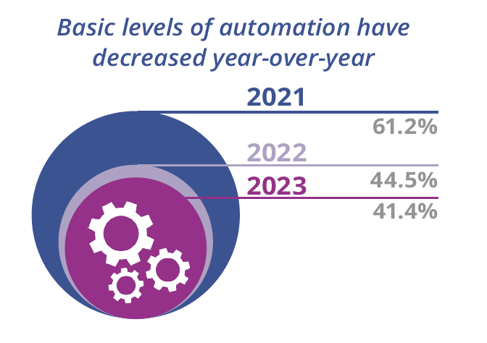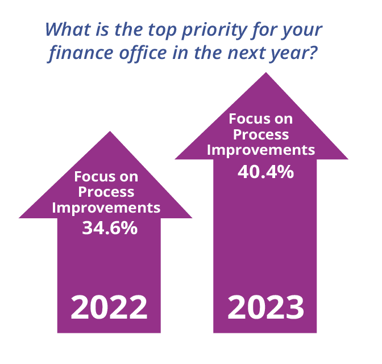Blog | AI In Finance
Chapter Four: Acceleration of Automation in the Finance Office - Year-Over-Year Trends
In the fourth chapter of the survey results ebook "2023 State of Automation in the Finance Report: Full Throttle for Finance Automation,” we explore the trends that have shaped the finance landscape over the years and how automation is driving progress in the finance office.

Understanding Finance Professionals' Priorities
Year after year, finance professionals have been on a quest for efficiency and effectiveness. Their priorities have evolved, reflecting their relentless pursuit of improvement.
In 2021, 38% of professionals aimed to invest in new technologies to enhance their processes, showcasing their recognition of technology's potential in driving efficiency.
In 2022, 34.6% expressed their desire to focus on process improvements, emphasizing their dedication to streamlining operations and optimizing workflows.
Additionally, 21.2% planned to implement analytics and reporting tools to enhance decision-making capabilities.
In 2021, 38% of professionals aimed to invest in new technologies to enhance their processes, showcasing their recognition of technology's potential in driving efficiency.
The Fluctuating Levels of Automation
The data reveals that basic automation levels have been decreasing over the past three years. However, when viewed alongside the overall percentage of respondents using some form of automation, it shows that more finance departments are reaping the benefits of automation and moving towards more advanced technology.

Striving for Efficiency with Automation
Despite growing recognition of automation's benefits, there remains a sense of untapped potential in the finance back office. In 2022, 61.8% of respondents felt their finance back office lacked sufficient automation, indicating a gap between aspirations and reality.
However, 22.9% primarily utilized automation in accounts payable processes, showing progress in specific areas.
In 2021, 58% of respondents indicated a shortfall of automation in their finance back office, while 42.2% revealed they were yet to harness the power of artificial intelligence in financial processes.
These statistics suggest that while automation has made some headway, there's still ample room for growth and adoption of AI technologies to enhance efficiency.

Navigating the Data Maze
Gathering data for analysis remains a top time-consuming activity for finance professionals. Data fragmentation makes consolidating and reconciling information challenging, leading to time-consuming manual efforts to collect and organize data from disparate sources. This diverts finance professionals' attention from more strategic tasks and hampers productivity.
Data fragmentation makes consolidating and reconciling information challenging, leading to time-consuming manual efforts to collect and organize data from disparate sources.
Top Challenges: Seeking Improvement
Finance professionals face common pain points, such as repetitive and manual tasks, which hinder productivity and job satisfaction. Lack of responsiveness stands as the most acute pain point in finance work, impeding agility and decision-making processes.
By utilizing automation insights, finance teams strategize and enhance employee satisfaction and efficiency. Process optimization, workload distribution, and staffing allocation further improve the finance office's effectiveness.

The finance office is on the fast track of innovation, embracing automation to drive progress and efficiency. As finance professionals continue their quest for improvement, automation will play a pivotal role in unleashing the potential of technology.
By staying ahead of the trends, finance teams navigate the ever-changing data maze with ease, optimize processes, and make strategic decisions with confidence.
As we race towards the future, the acceleration of automation in the finance office will continue to shape the landscape and revolutionize finance operations for years to come.
Read more in our 2023 State of Automation in the Finance Office report: Full Throttle for Finance.
